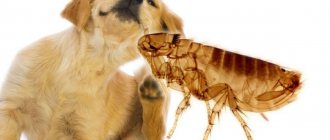If your hamster has fleas, you need to act very carefully. The health of a rodent depends on the correctness of its actions and the chosen treatment methods. Neglect can result in the death of a pet or unpleasant consequences for a person.
To paraphrase a well-known saying, we can say that the person who tamed the animal is responsible for its future fate. Firstly, a small hamster is not a funny “toy”, but a living creature with its own “problems”. The animal may become sick and become infected with parasites. The owner will have to save the animal.
Can a hamster have fleas?
When asked whether hamsters have fleas, you need to look for the answer before the animal enters the house. The decision to have a pet should be a conscious one, so you should initially become familiar with the peculiarities of keeping animals in the house and possible diseases of the rodent. Yes, hamsters have fleas!
The animal's body is covered with fur, and the skin is easily bitten by parasites. Contrary to popular belief, fleas do not live directly on the body of animals, but regularly feed there. For parasites, it does not matter whose blood they drink: a cat, a dog, a mouse or a hamster.
Fluffy Syrian, Royal and Angora hamsters are most susceptible to pest attacks. Animals of the Dzhungar and Roborov breeds suffer less from this scourge.
Appearance and ways of their appearance
Insects that live in a hamster's fur are practically no different from those that live on cats and dogs . They can jump from place to place and live not only on the hamster, but also on other animals. Read about fleas in cats and dogs.
their body is flattened, only about 3 mm. Almost the entire body is brown.
They reproduce due to the presence of a dog or cat nearby, because a flea can jump up to 30 cm . Also, unexpected guests can be brought by a person on his shoes or clothes. We wrote in detail about how fleas can appear in an apartment in a separate article, and you will learn how they reproduce here.
Routes of infection
Fleas on a hamster are not a natural phenomenon. This animal is not their permanent “master”. However, under certain conditions they can tire the animal for a long time.
Main sources of infection:
- Other pets and parasites. Cats, dogs, as well as rats and mice are brought into the house. Infection occurs during mating if one of the participants in the process is a temporary host.
- Stay at the pet store. There are situations when a pet is brought into a home already infected. Symptoms are not visible at first, but appear over time.
- Street grass. Rodents are offered green grass that grows outside as food. Eggs and insects themselves are found in sand, soil and thickets. Therefore, the person himself brings the infection into the house.
The likelihood of infection is low, if there are no other pets in the house, feed the animal with special food and prevent the presence of street rodents.
Prevention measures
The following preventive measures will help prevent the proliferation of parasites in the apartment:
- Regularly inspect the fur of pets that take walks outside. If parasites are found, the animals are immediately treated with insecticides.
- Strong-smelling herbs, such as wormwood, repel fleas. The branches of the plant are laid out around the cage. Their smell will not disturb the animals, and parasites will not want to live there.
- The hamster's cage and household items are regularly cleaned and treated with insect repellents.
- The hamster is often let out for a walk around the apartment. If it is located on the lower floor of a high-rise building, near the basements, then there is a high probability that the animal will be attacked by fleas. To prevent this from happening, the animal is treated with insecticides from time to time for prevention, even if there are no parasites in the apartment.
- If a new hamster is brought from a pet store, then before moving it in with neighbors, it is treated with an insecticide and kept in quarantine. Only after this the animal is placed in a common cage.
- If a hamster is taken out into the wild, it can become infected with fleas. Before the trip, he is treated with anti-parasite medications.
If a hamster living in the house begins to itch furiously, its owner suspects that the animal has been attacked by fleas. In this case, the pet is shown to the veterinarian. If infection with ectoparasites is confirmed, the apartment, cage, and the rodent itself are immediately treated with insecticides. To prevent the proliferation of bloodsuckers, preventive measures are regularly carried out.
Symptoms of flea infestation
The presence of parasites can be recognized by their characteristic signs. Fleas cause discomfort and pain to your hamster. The behavior and appearance of the animal changes. He becomes restless, sleeps poorly, loses his appetite, often itches and chews his fur.
The examination reveals:
- blisters and bite marks on the body;
- encrusted blood stains;
- sand-like grains;
- receding hairline;
- combs.
If the owner leaves the pet without proper attention, infection penetrates into the wounds, inflammation begins, and purulent formations appear.
Symptoms
Hamsters are clean animals, but the hamster flea washes, scratches, licks and bites their fur.
Enhanced grooming
Fleas feed little and often, so even a few insects will bother the owner with bites. Insect saliva contains enzymes that prevent blood clotting. These substances cause inflammation and swelling at the bite site, as well as severe itching. An allergy to flea saliva is a painful problem for your pet.
Fleas, unlike other blood-sucking insects, do not inject pain medication into the victim when they bite. Therefore, the hamster may suddenly jump or flinch when attacked by the parasite, after which he begins to wash himself vigorously or itch again.
Skin problems
Due to constant itching, scratches appear on the hamster's skin - he is injured. Nail wounds can become infected and worsen. Patches of baldness appear on previously thick fur.
Detection of parasites or their feces
If you spread out the wool and examine the skin of the animal, you will notice black grains. These are clots of undigested blood, flea droppings. And only with great luck can you spot the insects themselves.
Fleas of Djungarian hamsters will hide in secluded places - in the armpits, on the animal’s neck. The dark, thick fur and small size of the rodent make the search very difficult. Syrian hamsters are larger and easier to examine, but sometimes it is best to leave this to a specialist. It is impossible to say for sure whether hamsters have fleas if the owner does not see them. The ratologist will not be guided by the presence of fleas, but by indirect signs of their presence.
The danger of parasites for hamsters and humans
Severe infection leads to death in a short time. Parasites irritate with their bite, drink blood, exhaust and weaken the animal. In addition, the presence of insects on a pet’s body is dangerous for the development of other serious diseases.
- Fleas are carriers of helminth eggs. At the moment when the rodent tries to remove the leech with its teeth, the worm eggs enter the hamster's body. The first symptoms of infection may appear after 14 days.
- Infection occurs in open wounds and scratches. Dermatitis, eczema, and abscesses appear on the body. In addition, insects spread plague, salmonellosis, and typhus.
- The flea animal loses sleep, appetite and strength. Nervous and physical exhaustion leads to death.
Insects are not that dangerous to humans. Fleas do not specifically attack people; they attack when a room is heavily infested.
Health Hazard
Of course, the very presence of parasites and their bite are not fatal, but the danger is still present and the consequences can be quite serious:
- A hamster can become infected with helminths in the process of biting parasites out of its fur. Most often, after flea treatments, an anti-helminth drug is given.
- Remember that these parasites carry typhus, plague and salmonellosis, diseases that are fatal.
- Skin diseases appear, which without the necessary treatment can cause serious complications.
- Remember that the hamster suffers a lot due to the bites and constant itching, which causes stress. Their appetite decreases, sleep is disturbed, which leads to weight loss. The pet becomes lethargic, but at the same time can show aggression.
Rodent treatment
After you have discovered fleas on your hamster, it is worth asking the pressing question of how the infection occurred. Timely treatment ensures a quick recovery for the pet and a restful sleep for the owner.
What you should not do is bathe your hamster with flea shampoo for cats and dogs. Animals do not tolerate water procedures well and risk dying from a cold. It is recommended to use special products at home or seek help from a veterinarian.
Flea drops
They are considered the most effective and convenient to use. To fully treat the animal, you need to apply 1-3 drops of the product to the withers, where the hamster cannot reach the teeth.
Within 2 hours, the active components are completely absorbed by the skin, localized in the hair follicles and in the upper layer of the epidermis. The poison enters the body of insects through bites.
The effect of the drug lasts from 1 to 3 months. Drops are used to treat and prevent re-infection.
For the treatment of rodents, it is recommended to choose safe agents whose active components do not enter the systemic bloodstream. These include, for example, drops for treating cats.
A product for dogs is also produced under this brand, but the dosage is higher, so it is not suitable in this case. If your hamster has fleas and you don't know what to do, buy a few drops for cats and apply them once.
Injections
This treatment method is suitable when the animal is heavily infected and the likelihood of reinfection is high. The veterinarian knows very well how to remove fleas from a hamster with an injection, so there would be no shame in using his services.
The product used can cause serious side effects, including death, so the rodent should be tested the first time. Typically, ivermectin 1% is used twice at 15-day intervals.
Insecticidal powder
The product in powder form is applied to the animal’s body and gently rubbed into the skin. The active components begin to act immediately. Insecticides paralyze insects on contact, after which they die.
The action lasts about 2 weeks. If necessary, repeat the course of treatment. For the treatment of domestic hamsters, veterinarians prescribe Insectal and Celandine.
Anti-parasite sprays
The drug is produced in finished form in a special aerosol can. To remove fleas from a hamster, it is enough to treat your pet's fur once.
The spray gun should be kept at a distance of 5 cm from the surface to be treated. The product dries quickly, but preferably 20 minutes after treatment, make sure that the pet does not lick the spray from the fur.
It is recommended to use a special Ultra Care spray for rodents, a flea and tick spray for small animals, or a product for cats, such as bars.
Insecticidal preparations for hamsters
You can treat your hamster with a spray or drops on the withers; injectable preparations are available. You should also treat the “culprit” - a cat or dog, but only with those products that are intended directly for them. The area of the home, furniture and household items are treated with preparations in the form of a powder dissolved in water or a preparation diluted with water from an ampoule.
Front Line and Le Artis
There are many remedies that will effectively rid your baby of parasites, and your home of traces of their presence. They are available at any pet pharmacy and any veterinary hospital. Popular drugs are Le-artist, Stronghold, Ivermectin, Frontline, 8in1, BioVax and Botfo powder. They have proven themselves well and have been tested in practice.
Flea drug Stronghold
Important! Under no circumstances should you wet, bathe, or rub your hamster with shampoo!
Cell processing
Adult insects jump onto the animal's body for the purpose of feeding; they are rarely found there all the time. The eggs are scattered throughout the house, and the larvae often develop in the litter tray, the hamster's cage. To destroy parasites, it is necessary to clean the “house” and disinfest the cage.
Remove food debris, clean bowls, drinking bowls. Toys are washed with soap. The bed is washed and then steamed. The cage is treated with an insecticidal spray. Any product will do, including Dichlorvos. They do this in the fresh air and after 3 hours you can throw the animal there.
general description
If we talk about parasites such as fleas, it should be said that there are a huge number of varieties. For example, cats, dogs, mice and many others. But the fact is that they all have a fairly good appetite and, in search of food, do not go overboard when choosing a victim. So, a hungry dog flea can bite absolutely all warm-blooded animals.
Regarding the most common parasites, these include the cat flea. She can also attack hamsters, but only to satisfy her hunger. They do not take root on little furry friends, so after satisfying their hunger, they most often leave it. But parasites such as rats and mice pose a very great danger to animals.
Treating all pets and your home for fleas
Since the rodent cage is indoors and flea eggs may be scattered everywhere, it is recommended that all pets be washed and treated.
In case of severe infection, it is recommended to disinfest the premises; in other cases, folk remedies are used.
- Sprinkle carpets with boric acid powder and vacuum every other day.
- Wash floors with water and vinegar or ammonia. For 1 liter of water, one tablespoon of product.
- Clean the walls with a solution at a height of 1 m above the floor level.
- Pour boric acid into the cracks.
Be sure to treat the room, otherwise you will have to constantly fight pests.











